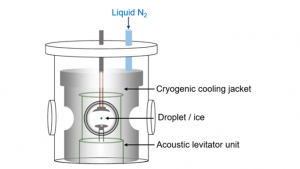A groundbreaking University of Hawaiʻi at Mānoa study on the freezing of water droplets suspended in air sheds light on a key process in Earth's water cycle: the transformation of supercooled water into ice.
Conducted using a novel cryogenically cooled ultrasonic levitation chamber, the research captures real-time molecular-level changes during the freezing process, mimicking conditions in the Earth's atmosphere. This innovative setup enables researchers to observe how water droplets transition to ice at subzero temperatures, providing valuable insights into cloud formation and precipitation.

This research ties into the larger effort by UH Mānoa researchers and their collaborators to address climate challenges through a $26 million project to develop sustainable refrigerant technologies .
"By uncovering the mechanisms of supercooled water freezing, we open pathways to innovations in low-temperature chemistry and climate-friendly cooling technologies," said UH Mānoa Department of Chemistry Professor Ralf I. Kaiser. "This research holds particular importance for Hawaiʻi, where sustainable cooling solutions are vital to addressing the region's unique environmental and energy challenges."
The research findings were published in the Proceedings of the National Academy of Sciences on February 3 .
More about the research

By recreating atmospheric conditions, including pressure and temperature variations, the study also opens the door for future experiments involving chemically reactive trace gases, advancing our understanding of ice nucleation (process where ice begins to form, starting with tiny ice crystals developing in supercooled water) under realistic scenarios. Understanding the molecular interactions driving ice formation can help refine models of cloud dynamics and precipitation patterns, both of which play critical roles in predicting weather and climate changes.
The refrigerant project focuses on reducing harmful emissions from heating and cooling systems, a major contributor to global greenhouse gases. By integrating findings from studies such as the water droplet research, scientists can better predict how new refrigerants interact with atmospheric ice particles, ultimately informing climate-friendly innovations.
As rising global temperatures drive increased demand for cooling, these research efforts underscore the need for interdisciplinary approaches to mitigate environmental impact while advancing scientific understanding of Earth's complex systems.






